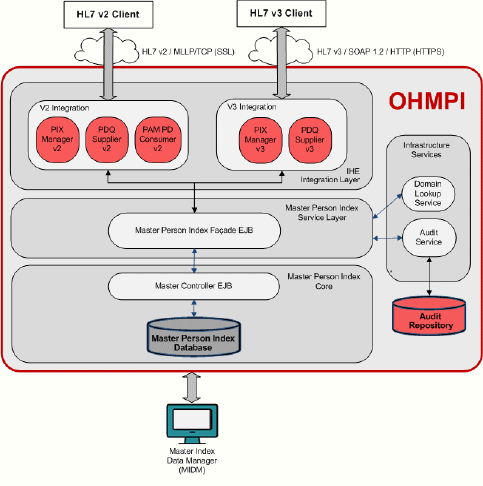| Oracle® Healthcare Master Person Index Working With IHE Profiles Release 1.1 Part Number E18591-01 |
|
|
View PDF |
| Oracle® Healthcare Master Person Index Working With IHE Profiles Release 1.1 Part Number E18591-01 |
|
|
View PDF |
This chapter provides an overview of Oracle Healthcare Master Person Index (OHMPI) and the IHE Profiles Application. It also provides links to instructions in the following chapters that help you understand and use OHMPI and the IHE Profiles Application.
This chapter includes the following sections:
OHMPI's IHE Profiles Application provides a flexible solution to healthcare integration needs. It uses processing logic based on the guidelines and standards put forth by the Integrating the Healthcare Enterprise (IHE) to assure compatibility with other vendors and healthcare organizations.
The IHE Profiles Application forms a specialized implementation of HL7 messaging that facilitates patient health information exchange, and supports both native HL7 v2 and HL7 v3 messaging. HL7 v2 is supported through the HL7 v2 server over the minimal lower layer protocol (MLLPV1 or MLLPV2). HL7 v3 is supported through SOAP 1.2 over HTTP.
The IHE Profiles Application leverages the advanced standardization and matching algorithms of Master Person Index to cross-reference and uniquely identify the patients in your healthcare organization. Master Person Index provides a single complete view of the participants in your healthcare system and is able to quickly reconcile which information is associated with which patient.
The IHE Profiles Application processes messages based on the IHE IT infrastructure technical frameworks, which define how to process HL7 messages using existing standards when available. In compliance with these frameworks, the IHE Profiles Application generates and maintains an audit repository of all events processed by the manager. Information about the state of the IHE Profiles Application components is provided by a common logging, alerting, error handling, and reporting mechanism.
The IHE Profiles Application has a number of layers that function inside of OHMPI, which are illustrated in "HL7 v2 and v3 Integration with OHMPI", and include:
Figure 1-1 HL7 v2 and v3 Integration with OHMPI

The IHE Integration layer adapts HL7 v2 and HL7 v3 messages to the simplified Java data model and service layer exceptions and vice versa. It also makes sure the message header properties (such as sending facility, receiving facility) are populated according to the specification.
The V3 Integration exposes OHMPI's functionality via SOAP version 1.2 over HTTP/HTTPS to IHE PIX/PDQ HL7 v3 clients. Its interface is defined by the IHE specification and the XSD/WSDL artifacts are provided by IHE.
The V2 Integration exposes OHMPI's functionality via TCP/IP-MLLP and HL7v2 based protocol to HL7 v2 clients.
The IHE Integration layer is HL7 v2 and v3 message-aware; that is, it can receive and validate incoming HL7 messages and handle standards-defined acknowledgements. HL7 v2 is supported through an HL7 v2 server that uses secured TCP/IP and Minimal Lower Layer protocol (MLLP). HL7 v3 is supported through SOAP messages transported over HTTP/HTTPS. Support for IHE Profiles in OHMPI is designed with the aim to implement the solution with minimal configuration level changes. This layer works seamlessly in tandem with the Master Person Index layer to provide the appropriate patient identity resolution and demographic information responses.
The Master Person Index Service Layer consists of the core set of services mapping PIX/PDQ/PAM operations and data into OHMPI. The interface to this layer is IHE aligned. This means that the data structures are simplified versions of the HL7 message formats. The operations are analogous to the operations defined in IHE.
This layer also implements the audit requirements and domain resolution (namespace ID and universal ID mapping) service.
Note:
There is no protocol specific functionality in this layer. It implements the response behavior of PIX/PDQ/PAM from a functional point of view.This layer is the core patient identity resolution component that leverages OHMPI's powerful matching and standardization engines to uniquely identify and cross-reference patient objects based on a canonical patient object model. OHMPI's powerful, extensible, and configurable Match Engine compares complex data records containing a multitude of datatypes and calculates a global composite weight that reflects how closely the records match. From this, OHMPI builds a cross-index that is used to provide a single view of the patient information from multiple source systems in real time.
As related to OHMPI and the IHE Profiles Application, the Audit Record Repository (ARR) is an audit server and repository which functions with a Domain Lookup Service that provides cross-referencing to identify a domain by domain ID (a.k.a. namespace ID) and/or universal ID, which in turn provides secure transmission, auditing, logging, alerting, error handling, and reporting for healthcare application systems. A supporting component is an audit service that generates audit messages and implements an IHE audit trail that is defined in the Audit Trail and Node Authentication (ATNA) Integration Profile.
This document includes several tasks that are optional and some that are required for a production environment. The tasks are listed by category below.
If you performed a complete installation of OHMPI, you are ready to work with the IHE Profiles Application and can start running test data and using the Master Index Data Manager (MIDM). See the following sections for instructions on running test data and monitoring the processed and data:
For a production environment, you need to configure certain variables unless you specified the correct values during installation, and each domain needs to be added to the IHE Profiles Application. Optionally, you can configure master person index processing.